Laptop Mag Verdict
The HTC Amaze 4G backs up its gorgeous design with fast 4G speeds and one of the best cameras you can get in a smartphone.
Pros
- +
Most attractive Android phone yet
- +
Fast dual-core speeds
- +
Capable of fast 4G downloads
- +
Sharp and powerful camera
- +
Loud speaker
Cons
- -
Relatively heavy
- -
Inconsistent 4G speeds
- -
Shorter battery life than T-Mobile's Galaxy S II
- -
Expensive
Why you can trust Laptop Mag
4G Data and Web Browsing
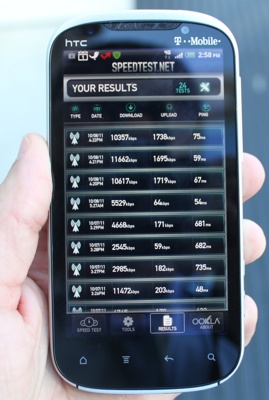
Click to enlargeThe HTC Amaze 4G is one of the first two phones on T-Mobile's network that support the carrier's HSPA + 42 technology, with claims of 8 Mbps downloads and peak speeds up to 20 Mbps. We did see some impressive data rates in our testing, with the Amaze 4G peaking at 15.2 Mbps on the download and 1.7 Mbps uploads in San Diego. When we were getting a good 4G connection, downloads averaged 7.9 Mbps and uploads averaging 1 Mbps. However, at one point the phone stopped delivering 4G speeds; rebooting the Amaze solved the issue.
Still, these are the some of the fastest results we've seen for T-Mobile, and comparable to what the carrier's new Galaxy S II offered in New York. That phone averaged 11.7 Mbps down and 1.7 Mbps up in one testing location, and 12.6 Mbps down and 1.6 Mbps up in another. These numbers are faster than the Amaze 4G in New York, New Jersey, and San Diego, but we'll need to put the two phones head to head to determine the best phone for data. Regardless, Verizon's 4G LTE phones offer much better upload speeds, ranging from 2 to 5 Mbps.
When surfing the web, the Amaze 4G took 9 seconds to download the mobile version of NYTimes.com, 6 seconds for ESPN, and 5 seconds for CNN. The full desktop version of CNN.com took a somewhat lengthy 27 seconds, but that includes Flash content.
Apps
HTC and T-Mobile bundle the HTC with a full suite of apps, starting with HTC Watch for purchasing movies and TV shows. Flicks such as Hall Pass cost $3.99 to rent and $14.99 to buy, and TV shows cost $1.99 to buy. The TV selection is pretty skimpy, with only 15 shows available.
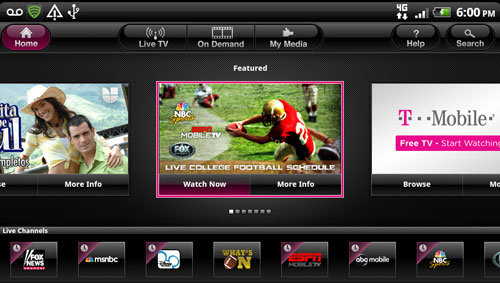
Click to enlarge
You'll also find HTC's FriendStream for checking the latest updates from Facebook, Flickr, and Twitter, and HTC Sync for backing up content to your PC. Third-party software includes Lookout Mobile Security for protecting your web browsing, privacy protection, and locating and wiping a lost or stolen phone. This is the premium version of the service, which costs $2.95 per month. The free version lacks many of the above features. For example, you can find your lost phone, but you can't wipe it or lock it.
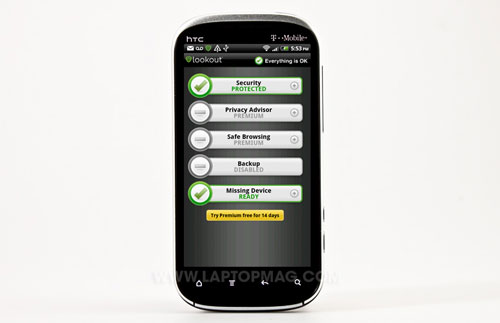
Click to enlarge
The Amaze 4G also comes with Polaris Office for reading and editing Office documents, Slacker Radio, and Zinio Reader.
Call Quality and Battery Life
The Amaze 4G impressed during our test calls. During a five-minute conversation, the other caller came through clearly and with plenty of volume. We noticed only a slight fuzziness during pauses. The caller said we sounded almost as good as when calling on a landline.
HTC packs this Android phone with a hefty 1730 mAh battery. However it only lasted 5 hours and 40 minutes during our battery test, which involves continuous web surfing at 40-percent brightness. That runtime is about 10 minutes longer than the Android average but below the Amaze's main competition. The Samsung Galaxy S II on T-Mobile has an even larger 1850 mAh battery, which lasted 7 hours and 31 minutes on the same test. That's a significant endurance delta.
Verdict
The Amaze 4G is undoubtedly one of the best-looking Android phones around, and HTC and T-Mobile back up those good looks with a fast processor, a fantastic camera, and impressive 4G speeds (at least on the download). The ultra-premium design and instant access to the camera and camcorder with dedicated buttons will lure many T-Mobile customers to this device. On the other hand, T-Mobile's Samsung Galaxy S II is cheaper ($259 vs $229), offers better performance with the same processor, and is much lighter. The S II also has a more vibrant Super AMOLED Plus screen--though it is lower res--and lasts longer on a charge. The S II also has a cheaper feel to it. Bottom line: So long as you don't mind the heft of the Amaze 4G, this superphone will definitely satisfy.

Click to enlarge
Software and Interface
If you're not familiar with HTC Sense, it's one of the reasons why you should get the Amaze 4G over a Samsung or Motorola Android phone. And it starts with the lock screen, which includes quick shortcuts for launching right to your favorite apps. For instance, you can pull the Email icon right into a ring and dive right into your inbox. You'll also find shortcuts for Camera, Phone, and Messages, but you can customize what appears on the lock screen.
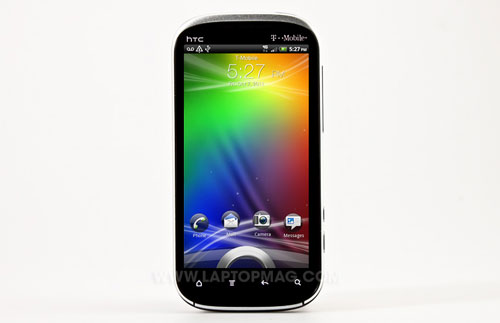
Click to enlarge
The main home screen should look familiar to HTC users, with the trademark larger-than-life clock with the latest weather update right beneath it. Tapping on the time will launch the clock app, with easy access to alarms, stopwatch, and more. If you tap on the weather, you'll see a cool animation along and hear a tune that matches the current conditions; for example, in San Diego the Amaze 4G displayed beams of sunshine along accompanied by an angelic "Ahhhh" sound. Cute.
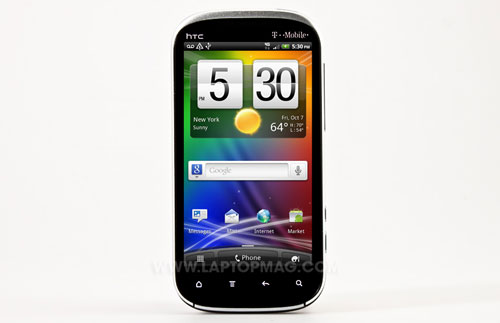
Click to enlarge
Swiping down from the top of the display reveals HTC's tweak of the Android notification drawer, displaying all the recent apps you had open from left to right along with alerts down below. If you click on the Quick Settings tab, you can toggle the wireless radios.
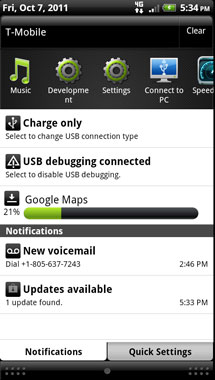
Click to enlarge
When you dig a little deeper, though, Sense could use a fresh coat of paint. Compared to the competition, the apps on the All App screens look dated. Worse, this screen has an annoying rubber band effect when you're scrolling, making it too easy to miss your target.
Specs and Performance
The Amaze 4G has considerably more brawn than the Sensation 4G, trading a 1.2-GHz dual-core processor and 768MB of RAM for a 1.5-GHz Snapdragon S3 CPU and a full 1GB of RAM. As a result, this Android device was smooth as silk, and offered improved scores in various benchmarks. However, the Samsung Galaxy S II with the same processor performed better.
In the CPU portion of the Benchmark app, the Amaze 4G notched 2,574, compared with 1,716 for the Amaze 4G. T-Mobile's Galaxy S II turned in an even higher score of 3,364 using the same S3 processor. The 1.2-GHz Samsung Exynos C210 processor inside the Sprint version of the S II got 3,164 on this same test.
In Linpack, which also measures processing prowess, the Amaze 4G returned a single thread score of 50.5, which is similar to the T-Mobile Galaxy S II (50.53), but the Samsung pulled away from the Amaze 4G in the multi-threaded portion of the test (65.8 vs 78.3).
In terms of graphics prowess, the Sprint Galaxy S II beats the Amaze 4G and the T-mobile S II. In An3DBench, the Amaze 4G scored 7,253, compared to 7,394 for the T-Mobile SII and a higher 7,937 for the Sprint S II.
Last but not least, the Amaze 4G trailed the T-Mobile S II slightly in the demanding Quadrant benchmark, which evaluates processing and graphics performance. The HTC device got 2,339, compared to 3,046 for the Samsung.
The Amaze 4G has 16GB of internal memory, which you can expand up to 48GB via the microSD card slot.
Camera and Camcorder
One of the key ways in which the Amaze 4G lives up to its name is its 8-MP camera. It's loaded with features, including auto face detection, dual flash, and a backside illuminated sensor paired with an f/2.2 lens for crisp shots in low light. The Amaze 4G also let us start taking pictures or video almost immediately, with dedicated launch buttons that work even if the phone's screen is off.
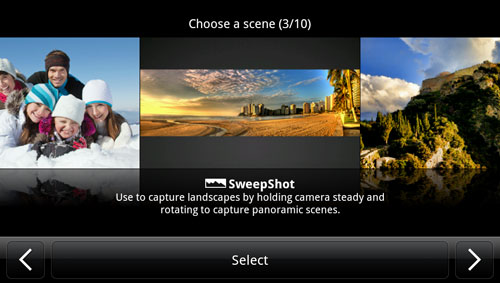
Click to enlarge
One of our favorite features is SweepShot, which we used to capture a panoramic shot in downtown San Diego. Once you activate this setting, you press the shutter button and pan the phone slowly around. It worked well, though we suspect that some users will have trouble finding this and other scenes; you get to them by touching the top left corner of the screen.

Click to enlarge
So what about speed? The Amaze 4G is supposed to have zero shutter lag, but that's somewhat misleading. There's practically no shutter lag after the autofocus locks onto your subject, during which time a circle spins on screen. You could turn autofocus off, but it will result in blurrier photos.
Our test photos in San Diego were colorful and bright, with just minor softness. We were especially impressed with a shot the Amaze 4G took of the entrance to the Gaslamp Quarter, with a pristine blue sky and plenty of detail in the palm trees and even the brick buildings behind them. Indoors, the flash was powerful without blowing out subjects.
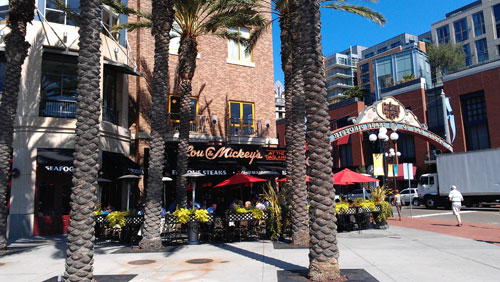
Click to enlarge
The Amaze 4G packs a 1080p camcorder that captured bright and colorful footage outside the San Diego Convention Center. We noticed some hitching during playback, however, and a few artifacts as we panned up to the crystal-blue sky. Indoors, the flash was powerful without blowing out subjects.
Although the Amaze 4G supports Qik video calling with its 2-MP front-facing camera, we didn't have much luck with the service. Despite multiple attempts to call (or receive calls) from the T-Mobile Galaxy S II, we saw blocky images on both ends of the line, and we experienced multiple dropped connections.
The HTC Amaze 4G takes one of the best cameras in a phone ever--from the myTouch 4G Slide--and puts it inside an exquisitely designed device with a larger 4.3-inch screen and a faster 1.5-GHz dual-core processor. It's like the Sensation 4G, but with a lot more speed and class. But that's not all this premium T-Mobile handset has going for it. It's one of the first phones to ride on the carrier's 42-Mbps 4G network, promising downloads speeds in excess of what many home Internet connections provide. Then again, $259 is pretty steep for a T-Mobile phone, especially when the Samsung Galaxy SII costs $30 less. Does the Amaze do enough to justify the price tag?
Design
Simply put, the Amaze 4G is the most beautiful Android phone we've ever laid eyes on. A smooth and curved metal finish surrounds the edge of the device, which continues as a band on the back that's flanked by two black soft-touch panels. (You can get the Amaze 4G in white, too.) We also like how the display is slightly elevated from the front of the device, which creates the illusion that the screen is floating above the rest of the design.
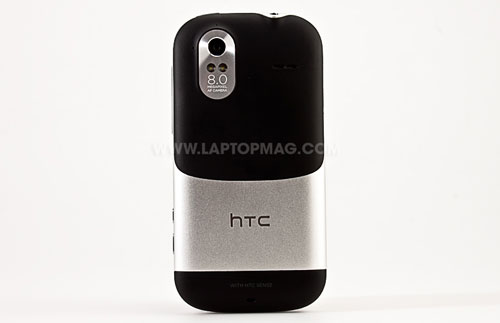
Click to enlarge
The Amaze 4G feels rock solid, but it's a little slippery in the hand. The main trade-off for this unparalleled sturdiness is that it weighs a hefty 6.1 ounces and measures a somewhat beefy 0.46 inches thick. By contrast, T-Mobile's Samsung Galaxy S II weighs 4.7 ounces and has a thinner 0.37-inch profile. The Sensation 4G (5.2 ounces, 0.44 inches thick) was also lighter and thinner. The Amaze 4G definitely weighed down our pocket more. We barely noticed the Galaxy S II, although it's slightly wider because of its larger 4.5-inch screen.
The top of the Amaze 4G houses the power button and headphone jack. A narrow but tactile volume bar along with two camera buttons--one for taking photos and one for video--line the right side. You can use these buttons to fire up the camera. That just leaves the microUSB port on the left side. You won't find an HDMI port here, but an adapter is available. The 8-megapixel camera with dual-LED flash and speaker sit on the back of the phone.
Overall, we'd proudly carry the Amaze 4G. We just wish it were a little lighter.
Display and Audio
Sporting a super LCD qHD (960 x 540 pixels) resolution, the Amaze 4G's 4.3-inch screen is bright and delivered vibrant colors when we streamed a high-quality Three Musketeers trailer on YouTube. Reds in particular really popped. However, this handset's display doesn't offer as much contrast as the Super AMOLED Plus panel on the Galaxy S II. More details got lost in darker scenes. The S II also has wider viewing angles. Nevertheless, viewing photos and captured videos with this device's camera was a pleasure. We also appreciated the crisp text and bright whites on web pages.
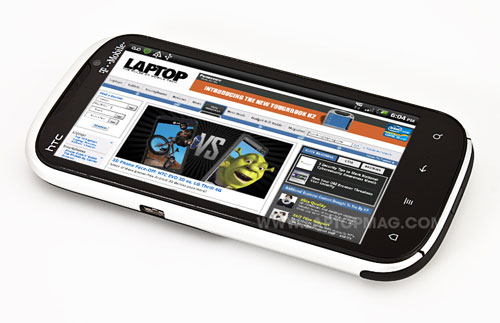
Click to enlarge
The Amaze 4G's speaker got pretty loud when playing music. Although the speaker is on the back, the sound got amplified when we placed the phone on a desk (muffled on a bed). We could easily hear Arcade Fire's "We Used to Wait" across a hotel room, and there was only minimal distortion at the max volume setting.
Keyboard
The more we use Android keyboards, the more we like HTC's the best. Not only was the layout on the Amaze 4G highly accurate in portrait mode--we hate having to turn the phone sideways to get better results--it provides reassuring but light haptic feedback.
We also like that HTC continues to include lots of keyboard shortcuts; you can long-press to enter everything from numbers and other special characters. You'll also find dedicated @ and .com keys appear when entering e-mail addresses and websites, respectively.
Not a fan of hunting and pecking? Try out Trace, HTC's Swype alternative that lets you type words by tracing a line from one letter to the next. It worked well in our tests, but we got tripped up when having to switch between one- or two-letter words and longer words.
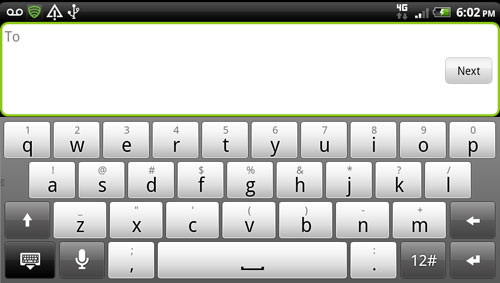
Click to enlarge
HTC Amaze 4G (T-Mobile) Specs
| Brand | HTC |
| CPU | 1.5-GHz dual-core Qualcomm APQ8060 |
| Camera Resolution | 8 MP |
| Carrier | T-Mobile |
| Company Website | http://www.htc.com |
| Data | HSPA+ |
| Display (main) | 4.3-inch super LCD qHD (960 x 540) |
| FM Radio | Yes |
| Form Factor | Candybar Touchscreen |
| Front Camera Resolution | 2MP |
| GPS | Yes |
| Internal Memory | 16GB |
| Memory Expansion Type | microSDHC |
| Networks | GSM/EDGE 850/900/1800/1900 |
| Operating System | Android 2.3 |
| Ports | 3.5mm headphone |
| RAM | 1GB |
| Size | 5.11 x 2.58 x 0.46 inches |
| Talk / Standby Time | 6 hours/11 days |
| Weight | 6.1 ounces |
| Wi-Fi | 802.11b/g/n |

